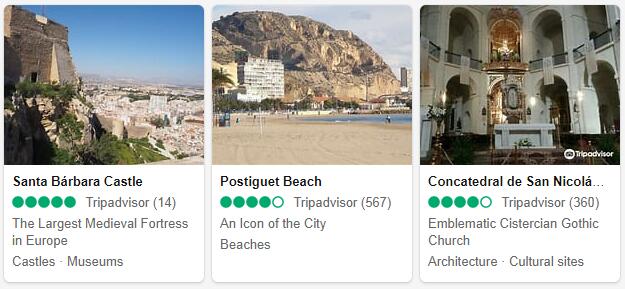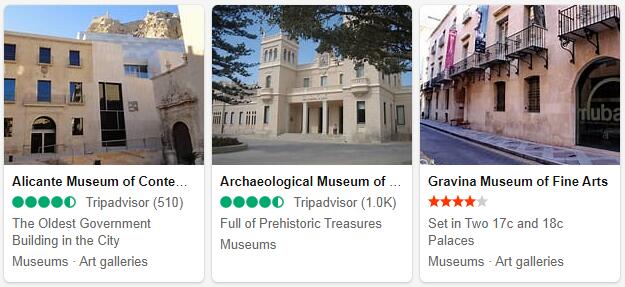Attractions in Alicante
Castello de Santa Bárbara
Almost wherever you move in the city, you will see the fortress of Castillo de Santa Bárbara rising majestically over Alicante on the 166-meter-high Benacantil hilltop. The fortress was originally built in the late 800’s by the Arabs who at that time had control over much of the Iberian peninsula. From the top, you have perfect 360 degree panoramic views of Alicante, the Mediterranean and the country within.
You can take a lift up to the top from the Postiguet Beach, you can drive up a winding road on the back of the hilltop, or the more fractious can choose to head to the top of the old city walls which still stand intact at the old town’s north side. Free admission, but if you pick up the lift, it costs about 30 kroner. Open daily 0900 to 19:00 in the winter months October to March, 1000 to 2000 in the summer.
Lucentum near Alicante
In Albuferete, a few kilometers northeast of downtown Alicante, you will find the Roman ruin town of Lucentum, the forerunner of today’s Alicante. Here you can clearly see the remains of the city wall, the public baths, the forum and the watchtowers, as you walk through the old streets where signs show you what it probably looked like 2300 years ago.
Admission costs only a few euros, open from 1000 to 1400 and 1600 to 1800 in October to May. From 0900 to 1200 and 1900 to 2200 in June to September. Closed Mondays and Sundays.
Museo de Bellas Artes Gravina
Just north of Plaza Puerto del Mar you will find this classic art museum, located in an old mansion from the 18th century. Here, over 500 works of art from the Middle Ages and up to the 1920s are exhibited by several of Spain’s foremost artists.
Free admission, open Tuesday to Saturday from 1000 to 1400, and from 1600 to 2000. Sundays 1000 to 1400.
Archaeological Museum – MARQ
This huge and modern museum half a mile north of downtown exhibits over 81,000 objects, from the Stone Age to the Middle Ages. Although there is little information in English, most people will find this interesting and well worth a visit. Entry 25 kroner, children half price. Open Tuesday to Saturday from 1000 to 1900. Sundays 1000 to 1400.
Havnepromenaden
Alicante’s beautiful seafront promenade, Explanada de España, is an attraction in itself. For many decades, every Sunday, the town’s residents decorated themselves and strolled up and down here to socialize and meet people. The promenade is decorated in pattern with over 6.6 million black, red and cream tiles. Four rows of palm trees provide enough shade. You will also find street stalls offering crafts, clothing, souvenirs and more, while musicians and jugglers entertain.
Castillo de San Fernando
Alicante has two fortresses on each hill, and Castillo de San Fernando has come under the shadow of big sister Barbara. Fernando is much more dilapidated and overgrown, but you have almost as good views from here, and you get the area almost to yourself. This is a peaceful and desolate place in the middle of the city, with lion statues looking down at the harbor and large portal doors leading you nowhere. Castillo de San Fernando is located on a cliff a few hundred meters north of Plaza de Luceros, and you can easily walk up there on your own.
Cathedral of San Nicholas
Alicante’s foremost religious building is the San Nicholas Cathedral, which was built in the Renaissance style, but later received Baroque-style elements. The cathedral was built over the remains of an Arab mosque and is located in the middle of the old town of El Barrio. Free admission, open from 0730 to 1230 and from 1530 to 2000.
Postiguet Beach
Many come to the Costa Blanca to enjoy the sun and swimming on the beaches, and in Alicante you do not have to walk many meters from the center to find a long, wide and clean sandy beach. Postiguet Beach is located just east of the marina and is flanked by a palm-lined boardwalk. Here you can also rent sun beds and equipment for water activities.
Alicante City Hall
Alicante’s town hall, Ayuntamento, is a magnificent late 17th-century Baroque building with a 50-meter-long facade flanked by two matching towers. In the square in front there are constantly demonstrations, an everyday occurrence in Spanish society. At the bottom of the stairs in the town hall foyer is Spain’s zero point, the point where all the heights of the country are measured from below.
Tourist in Alicante
Getting around Alicante’s downtown areas and attractions on foot is not prohibitive for a normally trained person, but all the steep cobblestone streets and stairs make it difficult to get around by pushchair or in a wheelchair. Or on high-heeled shoes. If you are going to Albuferete or San Juan, you are dependent on transport. The buses and trains run frequently and do not cost a lot of dollars.
Day 1 in Alicante Attractions and Tourist

Start your day with a hearty breakfast before heading to Alicante’s main artery, the Explanada de España harbor promenade. This beautiful palm-lined promenade is a delight to stroll on, overlooking the fortress of Castillo de Santa Barbara and Alicante’s marina to the south. Swing out on the docks on the east side of the marina, and you’ll find many new eateries, clubs and helaterias. Here it is great to relax in the sea breeze with an ice cream or a cerveza while looking up at the fortress or looking at the ferries on the way to Mallorca, Ibiza or Algeria in Africa.
On the way back, continue straight ahead in Calle Cervantes at the roundabout at Plaza Puerta del Mar, until you reach Alicante’s Town Hall, a beautiful late 17th-century Baroque building. From the point at the bottom of the stairs at the entrance hall you will find Spain’s zero point, which all heights of the country are measured from.
Casco Antiguo – Alicante’s Old Town
A few blocks further northwest of Alicante is the city’s cathedral, San Nicolás de Bari, in the Renaissance style with some baroque elements, built over an ancient Arab mosque. You are now in the middle of Alicante’s old town, known as El Barrio, or Casco Antiguo the slopes of Mount Benacantil, under the Santa Barbara Fortress. This is the city’s premier nightlife area, with hundreds of restaurants, tapas bars, clubs and bars open on weekends until late into the morning.
If you are missing a city map, need more information or have any questions, you can take a detour a few blocks further west. Alicante’s tourist information office is located in the Rambla de Mendez Núñez street, where helpful and English-speaking staff are ready to provide you with the information you need.
Castle of Castillo de Santa Bárbara
If you now look up you will see the next attraction, the fortress of Castillo de Santa Bárbara. You can walk up the steep, winding cobblestone streets of the old town. In the upper Santa Cruz district you will find signs for both the fortress and the old convent of Ermita de Santa Cruz. Alternatively, walk up the Rambla, turn right into Avenida Alfonso X El Sabio, and find the entrance that leads you up Alicante’s old city walls. From here you can go up to the top of the hill and experience that the view becomes more magnificent for every meter you walk.
The fortress was originally built in the late 800’s by the Arabs who at that time had control over much of the Iberian peninsula. When you’re at the top, it’s easy to understand why the fortress was so strategically important. Here you have a perfect 360 degree panoramic view of the city center and the Postiguet beach. At the fortress area there is also an exhibition of modern art that may be worth bringing along, and a small cafeteria that sells refreshments that you will badly need after the trip up. If it gets too tough to get up, there is also a cable car above the Postiguet Beach which brings you both ways for a cheap sum of money. Or you can take the path up and walk down.
If you choose to walk down the road from the fortress, you will eventually reach Calle Vazquez de Mella. Just north of this street is Alicante’s large, modern archaeological museum, MARQ. Although little of the signage is other than Spanish and Valentinian, most people with historical interest will enjoy spending an hour or two here.
Dinner and nightlife
By the time you get back to the center, most shops, museums and eateries have probably taken siesta, so you might as well take a trip back to the hotel for a shower and a change of clothes, before it is time to start thinking about dinner . Spaniards eat very late, and you won’t find many places open until 2000. But you can, for example, stroll to Calle Mayor in El Barrio, where the entire street is now filled with dining tables outside countless restaurants and tapas bars. Or you can go out on the docks east of the marina, where you will find several places serving the Valencian region’s world famous dish, paella.
Afterwards, the road is a short return to Alicante’s lively El Barrio nightlife area, where you can enjoy yourself as long as you can.
Day 2 in Alicante Attractions and Tourist

Today you can go down to Plaza Puerto del Mar and hop on bus 21 or 22 northeast or take the local train to La Albufereta. Here lies the Roman ruin city of Lucentum, the forerunner of today’s Alicante. Here you can clearly see the remains of the city wall, the public baths, the forum and the watchtowers, as you walk through the old streets where signs show you what it probably looked like 2300 years ago.
Sun and bath in San Juan
Afterwards, continue a few more stops and get off at the Costa Blanca station. You are now at San Juan Beach, which is even nicer and not least has fewer sun worshipers than the more downtown Postiguet Beach. Here it is great to relax with a dip in the blue waves of the Mediterranean while grilling in the sun (remember sunscreen!) And refresh yourself with something cool in the new.
Shopping and dinner in Alicante
When you’re back in downtown Alicante, maybe it’s time to get some shopping done? Walk the harbor promenade west and turn onto the wide avenue Avenida Doctor Gadea. A few blocks to the left, you reach the side street Avenida de Maisonnave, which is considered Alicante’s best shopping street. There are countless shops and two shopping arcades, and of course the great Spanish department store El Corte Ingles.
In the evening you may want to try a real Spanish restaurant, with a good gourmet reputation? Then call 96573 0629 and reserve a table at Casa Canto, located in Avenida Pais Valencia in the Benissa district. This is a real family business that has been run by the Ivars couple and their two sons with success since 1983. The restaurant is very popular with Alicante’s locals. You can get a five course dinner for two including wine and mineral water for around NOK 600. NB! Closed Mondays.